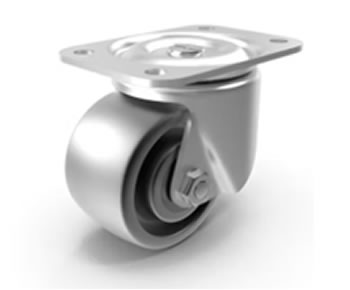Types of Casters
Casters are essential components used to enable easy movement of various objects. They come in a variety of types, each designed for specific purposes and environments. In this article, we'll explore the different types of castors commonly used in various applications.
Swivel Casters
Swivel casters are designed to rotate 360 degrees around a vertical axis. They allow for excellent maneuverability and are ideal for applications where precise and agile movement is required. Swivel casters often have a single wheel and a mounting plate or stem for attachment.
Rigid Casters
Rigid casters, in contrast to swivel casters, do not rotate. They provide stability and support, making them suitable for applications where straight-line movement is needed. Rigid casters are often used in conjunction with swivel casters to provide a balance between maneuverability and stability.
Locking Casters
Locking casters come with a mechanism that allows you to lock the wheel in place, preventing movement. This feature is valuable when you need to keep an object stationary, such as a piece of furniture. Locking casters are available in both swivel and rigid configurations.
Stem Casters
Stem casters have a stem, which is a vertical post, for attachment. They are commonly used in light to medium-duty applications and are often found on furniture, office chairs, and equipment racks. Stem casters can be either swivel or rigid.
Plate Casters
Plate casters have a flat, square or rectangular mounting plate with holes for screws or bolts. They are versatile and can be used in a wide range of applications, including carts, dollies, and material handling equipment. Plate casters can be swivel, rigid, or locking.
Ball Casters
Ball casters feature a spherical ball as their rolling element. They provide omnidirectional movement and are excellent for furniture and equipment that needs to move in any direction with minimal effort. Ball casters are often used in chairs and light-duty furniture.
hreaded Stem Casters
Threaded stem casters have a stem with threads that allow them to be screwed directly into the equipment or furniture. They are commonly used in situations where a secure attachment is required, such as medical equipment and displays.
Pneumatic Casters
Pneumatic casters have air-filled tires that provide shock absorption and a cushioned ride. They are suitable for use on uneven or outdoor surfaces, making them ideal for applications like garden carts and outdoor equipment.
Heavy-Duty Casters
Heavy-duty casters are designed to support significant loads. They feature robust construction with larger wheels and thicker frames. These casters are commonly used in industrial and manufacturing settings.
Dual-Wheel Casters
Dual-wheel casters have two wheels mounted side by side on a single swivel or rigid frame. They distribute weight more evenly and provide enhanced stability, making them suitable for heavy loads and industrial equipment.
Low-Profile Casters
Low-profile casters have a compact design and a lower overall height. They are often used in applications with limited clearance, such as under furniture or equipment with low ground clearance.
Decorative Casters
Decorative casters are designed with aesthetics in mind. They are commonly used on antique furniture and decorative pieces where the caster is visible, and its appearance contributes to the overall design.
Conclusion
In conclusion, the choice of caster type depends on the specific requirements of your application, including load capacity, maneuverability, and environmental factors. Selecting the right caster can greatly improve the functionality and usability of your equipment or furniture.










